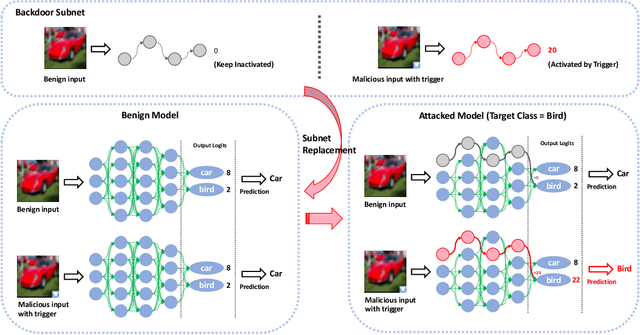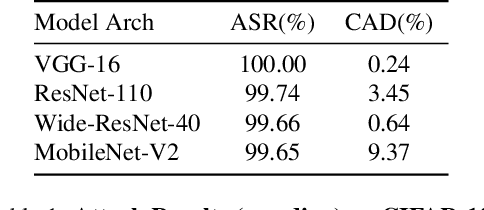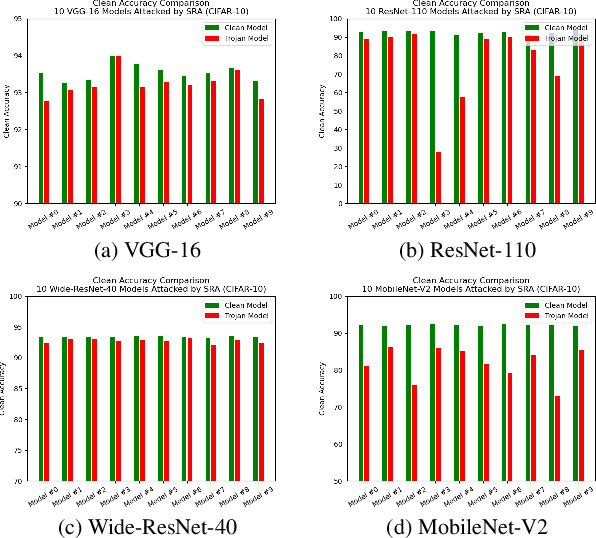Jifeng Zhu
Disappeared Command: Spoofing Attack On Automatic Speech Recognition Systems with Sound Masking
Apr 19, 2022



Abstract:The development of deep learning technology has greatly promoted the performance improvement of automatic speech recognition (ASR) technology, which has demonstrated an ability comparable to human hearing in many tasks. Voice interfaces are becoming more and more widely used as input for many applications and smart devices. However, existing research has shown that DNN is easily disturbed by slight disturbances and makes false recognition, which is extremely dangerous for intelligent voice applications controlled by voice.
Towards Practical Deployment-Stage Backdoor Attack on Deep Neural Networks
Nov 25, 2021



Abstract:One major goal of the AI security community is to securely and reliably produce and deploy deep learning models for real-world applications. To this end, data poisoning based backdoor attacks on deep neural networks (DNNs) in the production stage (or training stage) and corresponding defenses are extensively explored in recent years. Ironically, backdoor attacks in the deployment stage, which can often happen in unprofessional users' devices and are thus arguably far more threatening in real-world scenarios, draw much less attention of the community. We attribute this imbalance of vigilance to the weak practicality of existing deployment-stage backdoor attack algorithms and the insufficiency of real-world attack demonstrations. To fill the blank, in this work, we study the realistic threat of deployment-stage backdoor attacks on DNNs. We base our study on a commonly used deployment-stage attack paradigm -- adversarial weight attack, where adversaries selectively modify model weights to embed backdoor into deployed DNNs. To approach realistic practicality, we propose the first gray-box and physically realizable weights attack algorithm for backdoor injection, namely subnet replacement attack (SRA), which only requires architecture information of the victim model and can support physical triggers in the real world. Extensive experimental simulations and system-level real-world attack demonstrations are conducted. Our results not only suggest the effectiveness and practicality of the proposed attack algorithm, but also reveal the practical risk of a novel type of computer virus that may widely spread and stealthily inject backdoor into DNN models in user devices. By our study, we call for more attention to the vulnerability of DNNs in the deployment stage.
Subnet Replacement: Deployment-stage backdoor attack against deep neural networks in gray-box setting
Jul 15, 2021


Abstract:We study the realistic potential of conducting backdoor attack against deep neural networks (DNNs) during deployment stage. Specifically, our goal is to design a deployment-stage backdoor attack algorithm that is both threatening and realistically implementable. To this end, we propose Subnet Replacement Attack (SRA), which is capable of embedding backdoor into DNNs by directly modifying a limited number of model parameters. Considering the realistic practicability, we abandon the strong white-box assumption widely adopted in existing studies, instead, our algorithm works in a gray-box setting, where architecture information of the victim model is available but the adversaries do not have any knowledge of parameter values. The key philosophy underlying our approach is -- given any neural network instance (regardless of its specific parameter values) of a certain architecture, we can always embed a backdoor into that model instance, by replacing a very narrow subnet of a benign model (without backdoor) with a malicious backdoor subnet, which is designed to be sensitive (fire large activation value) to a particular backdoor trigger pattern.
 Add to Chrome
Add to Chrome Add to Firefox
Add to Firefox Add to Edge
Add to Edge